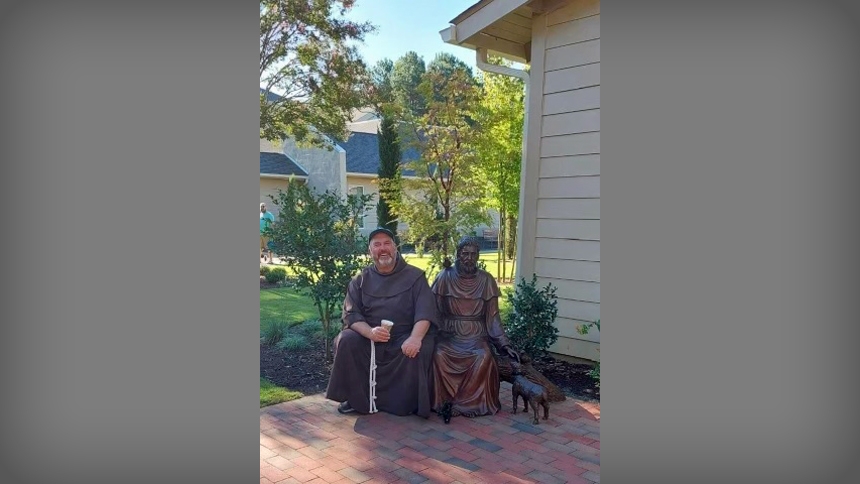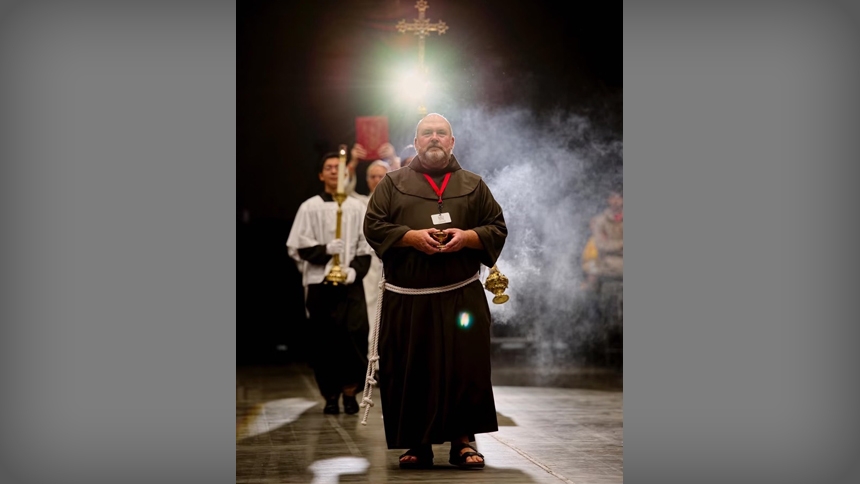
Last year, on a 95-degree day at dismissal time at The Franciscan School in Raleigh, North Carolina, students crowded the courtyard. Word spread that Father Jim Sabak, O.F.M., was sprinkling holy water, and everyone wanted in on the fun. Father Jim came up with the unorthodox idea as a way to keep the children entertained and cooled while they waited for pick-up by their parents – who found Jim’s creativity so engaging that they bought him a five-gallon backpack sprayer-tank to cover more ground.
Covering more ground is what led to Father Jim’s interest in becoming director of Divine Worship for the Diocese of Raleigh. It started out part time in 2018 when he was a member of the friar fraternity at St. Francis of Assisi Church, the school’s parish. The friars returned custody of the parish to the diocese in 2020, the same year Father Jim became full-time director and took on a second role: master of ceremonies for Bishop Luis Rafael Zarama.
Imagine the reactions when Father Jim showed up to his office at the diocese headquarters and at parishes, announcing himself as the bishop’s representative, dressed in shorts and a t-shirt! Or the horrified looks when Father Jim was wearing his Franciscan habit
with running shoes in the sanctuary of the cathedral. He doesn’t do such things for the attention, but rather to attract attention to the liturgy and liturgical services.
Although he spent virtually all of his friar life in higher education before his first assignment in parish ministry in 2017, his MC and director roles turned out to be matches made in skill-set heaven. He’s innovative, creative and down to earth; has a penchant for doing everything with verve and drama (although he maintains that the sneakers help with his plantar fasciitis); and he’s an academic with a Ph.D. in sacramental theology and liturgy who has authored books on Roman vigil liturgies in early Christianity, and who was professor of liturgy at Catholic University of America, Franciscan School of Theology, and Providence College.
And he can cook, often garnering the highest pledges at The Franciscan School’s annual fundraiser auction for his “Franciscan Experience” – which consists of Father Jim and the school’s principal preparing dinner for eight at the highest bidder’s home.
“We make a mess of their kitchen, but they get a great meal!” he says. His specialties are shrimp toast, roast pork loin, and skillet steak with thyme garlic butter. He manages to talk liturgy even at the dinner table.
“Instead of teaching methodology, now I am putting into practical use what liturgy should be, how it should encompass our lives, and how it should be celebrated and embraced,” explained Father Jim, who is a resource and guide to priests and parishes for their liturgical celebrations and prayer life.
Father Jim coordinates all major diocesan liturgical events (like Holy Week, ordinations, confirmations, and special Masses), gives workshops for lay ministers, and develops liturgy renewal for the diocese, which consists of nearly 100 parishes and missions in the state’s 54 eastern counties. He travels over 800 miles a month as the bishop’s MC, arriving at parishes and schools ahead of events and visits to ensure everyone knows their roles and that the “rituals unfold the way the Church intends them,” says Father Jim, who brings Franciscan tradition and values to all of his work.
Not everything he proposes is met with acceptance. When Father Jim announced that children would wrap around the sanctuary during Confirmation so their families could see them receiving the sacrament, some thought it was disrespectful to the bishop to have his back to the audience.
“Bishop Luis loved the idea because the children are the focus. This type of pastorally-minded view of liturgy and celebration brings us closer to God. We invite people to the sanctuary and show them they don’t have to be uptight around the bishop,” said Father Jim, who is thankful for the bishop’s support that gives him the “humbling and awe-inspiring” freedom to make sure people are getting everything possible from liturgical events – especially young people.
“We have to be dynamic when we are working with our youth. They will tune you out if they’re hearing a lot of boring, droning words,” says Father Jim. While some may view spraying holy water from a lawn and garden tank as radical, he sees it as a way to get the attention of youngsters. He is working with the diocesan school superintendent to deliver liturgy in a more vibrant way to students at the diocese’s 10 elementary and four high schools.
When he looks back on his faith growing up in an active Catholic family in Niagara Falls, New York, Father Jim realizes the call to vocation was always whispering in his ear. He was just ignoring it. The Franciscans weren’t his first, or even his second, choice. He wanted a career as a diplomat in the foreign services until religious vocation eventually came calling, only to fizzle out when the Jesuits weren’t a good fit. While trying to figure out his future, he took a job as a youth minister at St. Camillus Parish in Silver Spring, Maryland, where he met the friars. The third time was the charm. This year, Father Jim will mark three decades as a professed Franciscan.
“Being a friar is technicolor. It is vibrancy, it’s artistic. It enlivens and brings joy. St. Francis dreamed big and encouraged his followers to be creative,” said Father Jim, who is grateful to the diocesan pastor of St. Francis for allowing him to live at the parish and be a presence at the school that is a lasting and powerful vestige of the Franciscan identity.
Although he’s been with the diocese for over five years, some are still adapting to Father Jim’s style. “At least they no longer see me as this radical innovator – I think,” he quips, “but rather as someone who is trying to bring the light.”
This article originally appeared in The Franciscan Way. Republished with permission.





